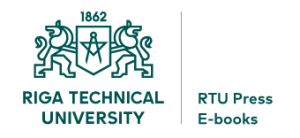Ilgtspējīga vēsturisko ēku attīstība
Summary of the Doctoral Thesis
Edīte Biseniece, Riga Technical University, Latvia
![]() https://orcid.org/0000-0001-8301-2442
https://orcid.org/0000-0001-8301-2442
Legal requirements as well as life quality requirements demand to increase energy efficiency of existing buildings, that has been seen to represent a huge potential in energy savings, based on the size of the segment and the individual potential. The biggest challenges during the renovation of buildings occur when it comes to historic buildings where the facade cannot be modified to maintain its unique architectural appearance and integrity. Policy makers and building owners are facing “building energy efficiency versus heritage value” dilemma when on the one hand it is important to preserve a building’s architectural value and on the other hand, energy consumption should be reduced significantly. Internal insulation is one of the energy efficiency measures that can be applied. However, this is one of the most challenging and complex energy efficiency measures due to changes in boundary conditions and hygrothermal behaviour of walls, especially for buildings in cold climate Applying of interior insulation significantly modifies the hygrothermal performance of walls and, as a consequence, may induce a risk on interstitial condensation, frost damage, mould growth and other damage patterns. The behaviour of internally insulated wall strongly depends on the properties of the used materials. There is a need to develop new methods and guidelines for decision makers on how to implement energy efficiency measures in historic buildings.
The aim of this Thesis is to offer safe and effective solutions for internal insulation systems of historic masonry buildings. To achieve this goal, the following tasks have been set: to perform historic construction material testing and analyse the test wall in a laboratory environment to determine the factors influencing the accumulation of moisture and the risks associated with it; to predict hygrothermal conditions of internally insulated masonry building using dynamic simulation program and to validate said models based on long term in-situ measurements in internally insulated case buildings; to estimate potential energy savings using dynamic simulation program. Several methods are combined within the research, including regression analysis, sensitivity analysis and heat and moisture transfer simulation validated by long-term in situ measurements.
Additional information
| DOI | |
|---|---|
| Hyperlink | |
| Defence date | 30.08.2021. |
| ISBN (pdf) | 978-9934-22-652-6 |
| Format | |
| Pages | 37 |
| Published online | |
| Publisher | RTU Press |
| Country of Publication | Latvia |
| Publication language |
You must be logged in to post a review.




Reviews
There are no reviews yet.